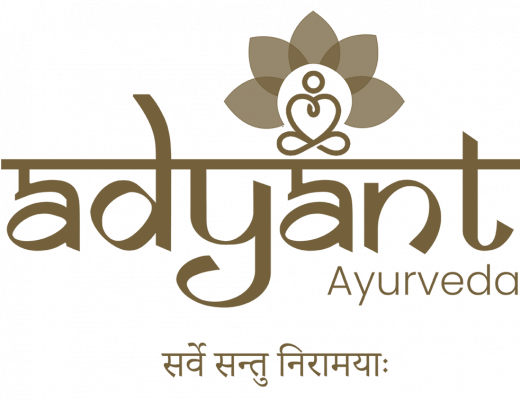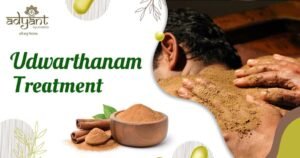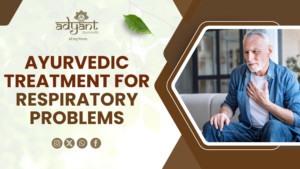Table of Contents
ToggleCervical Spondylosis—often called neck arthritis—is a degenerative condition that affects the vertebrae, intervertebral discs, and ligaments of the cervical spine. Common in people over 40, it causes neck pain, stiffness, radiating arm pain, and even neurological symptoms.
But what if your neck pain could be addressed at the root, gently and naturally?
Ayurveda, the 5000-year-old science of life, offers time-tested solutions for managing and even reversing the symptoms of cervical spondylosis through Panchakarma, herbs, and holistic lifestyle practices.
📖 What is Cervical Spondylosis?
Cervical Spondylosis is a condition where spinal discs lose fluid and elasticity over time, leading to bone spurs, disc bulges, and compression of nerves. According to Ayurveda, this condition aligns with Manyastambha, Grivastambha, and Sandhigata Vata—disorders rooted in aggravated Vata Dosha.
📌 Fun Fact: Nearly 85% of people over age 60 show signs of cervical spondylosis on X-ray—even without symptoms.
🌡️ Differential Diagnosis: Cervical Spine & Neck Pain Disorders
| Condition | Cause/Pathology | Key Symptoms | Ayurvedic Correlation | Diagnostic Tip |
|---|---|---|---|---|
| Cervical Spondylosis | Age-related degeneration of vertebrae/discs | Neck pain, stiffness, and radiating arm pain | Sandhigata Vata, Grivāgraha | X-ray shows osteophytes/disc narrowing |
| Cervical Spondylitis | Inflammatory autoimmune (e.g., Ankylosing Spondylitis) | Neck/back pain, morning stiffness, fatigue | Ama + Vata involvement | HLA-B27 test, ESR/CRP raised |
| Cervical Myelopathy | Spinal cord compression (stenosis/herniated disc) | Weakness, numbness in limbs, gait issues, and imbalance | Majjagata Vata + Marma Dushti | MRI shows cord compression |
| Fibromyalgia | Central nervous system sensitization | Diffuse body aches, fatigue, sleep issues, tender points | Vata-Pitta + Manas Roga | Clinical diagnosis, the tender points rule |
📚 Classical References for Grivāgraha (Cervical Stiffness)
📖 Ashtanga Hridayam Chikitsa Sthana 22.29:
“Snigdhaswinnasya vastishcha yuktā grīvāgrahe naram |
Bahiḥ snehascha svedashcha yojyāḥ shūlopaśāntaye ||”Translation: For stiffness and pain in the neck (Grivāgraha), internal oleation, medicated enemas, and external treatments like oil massage and sudation (Swedana) are effective.
📖 Charaka Samhita Chikitsa Sthana 28.37:
“Siraso gatavatah syad ardhavabhedakah shirah |
Grīvāgraham bhruśam shūlam, manobuddhi vināśanam ||”Translation: Vata vitiation in the head and neck leads to migraine, neck stiffness, pain, and disturbances in cognitive function.
🧠 Ayurvedic Pathogenesis (Samprapti) of Cervical Spondylosis
In Ayurveda, cervical spondylosis is understood as a manifestation of aggravated Vata Dosha in the Asthi and Majja Dhatus (bones and marrow). The natural lubricative support provided by Shleshaka Kapha in the cervical spine diminishes due to improper lifestyle, aging, and poor digestion (Agni), leading to:
Dryness in intervertebral discs
Loss of cushioning (disc degeneration)
Compression of nerves (Rakta/Marma injury)
📖 “Vatapradhānāni vyādhīni sthirāṇi bhavanti hi”
(Diseases due to Vata tend to be chronic and degenerative in nature) – Ashtanga Hridayam
🧠 Ayurvedic Perspective: Vata Imbalance
In Ayurveda, Vata dosha governs movement and nervous system function. Cervical spondylosis stems from Vata aggravation, often caused by:
Dry, cold weather
Poor posture
Stress
Lack of nourishment
Overexertion
“Grīvāgrahaṁ bhruśaṁ śūlaṁ…”
(Charaka Chikitsa 28.37) – Describes pain and stiffness in the neck due to Vata vitiation.
🧬 How Ayurveda Heals Cervical Spondylosis
Ayurveda heals cervical spondylosis through a multi-layered approach:
Snehan (Oleation): Rehydrates intervertebral discs and nourishes cervical vertebrae
Swedana (Sudation): Opens channels (srotas), releases stiffness, and pacifies Vata
Basti (Medicated Enema): Eliminates systemic Vata and detoxifies the colon-spine axis
Nasya (Nasal Therapy): Rejuvenates brain and cervical nerves, relieves compression
Rasayana (Rejuvenation): Strengthens the nervous system and prevents recurrence
🔬 Modern vs Ayurvedic Approach
| Parameter | Modern Medicine | Ayurvedic Management |
|---|---|---|
| Focus | Symptom relief | Root cause elimination |
| Tools | NSAIDs, physiotherapy, and surgery | Panchakarma, herbs, diet, yoga |
| Outcome | Temporary relief | Long-term healing and rejuvenation |
| Side effects | Common with prolonged meds | Minimal if supervised |
🔍 Ayurvedic Diagnostic Parameters
To diagnose cervical spondylosis from an Ayurvedic perspective, the following assessments are performed:
Prakriti (Constitution): Most patients present as Vata-Kapha dominant
Roga Marga (Pathway): Madhyama Roga Marga — the disease affects the deeper musculoskeletal system
Nadi Pariksha: Gati (pulse movement) is often Manduka (frog-like) or Sarpa (snake-like), indicating aggravated Vata
Lakshana (Symptoms): Stambha (stiffness), Shoola (pain), Spandana (spasm), Bhrama (giddiness)
🧪 Additional Parameters:
Asthi-Majja Dushti: Involvement of deeper Dhatus (tissues), especially Asthi (bone) and Majja (marrow).
Marma Involvement: Griva Marma injury or compression affects Prana flow to the upper limbs and brain, leading to symptoms like tingling or dizziness.
Vata Gati Assessment: Nadi with Manduka or Sarpa Gati suggests vitiated Vata, particularly in Madhyama Roga Marga (musculoskeletal pathways).
🛠️ Panchakarma Therapies for Cervical Spondylosis
1. 🧴 Abhyanga (Herbal Oil Massage)
Promotes circulation
Relieves muscle spasms
Lubricates joints
2. ♨️ Patrapinda Sweda (Leaf Poultice)
Herbal leaves + medicated oils
Relieves stiffness and inflammation
3. 💧 Greeva Basti (Neck Oil Retention)
Warm oil is retained over the neck in a dough dam
Deeply nourishes discs, nerves, and vertebrae
Improves range of motion
Case Insight: In a 2023 study, 16 days of Greeva Basti and Patrapinda Sweda showed over 50% reduction in pain and improved cervical motion in MRI-confirmed cervical spondylosis.
4. 💨 Nasya (Nasal Administration of Oil)
Clears Kapha from the head and sinuses
Strengthens cervical nerves
Reduces inflammation
5. 💉 Yogabasti / Kalabasti (Medicated Enemas)
Eliminates vitiated Vata
Nourishes the spine from within
🌿 Internal Ayurvedic Medicines & Herbal Compounds for Cervical Spondylosis
Ayurvedic treatment for cervical spondylosis includes a carefully selected combination of herbal formulations and classical medicines. These work synergistically to reduce inflammation, strengthen nerves and joints, and restore spinal health.
📋 Clinical Ayurvedic Formulations & Dosages
| Medicine | Dosage | Therapeutic Action |
|---|---|---|
| Yogaraja Guggulu | 500 mg twice daily | Reduces stiffness, detoxifies joints, and balances Vata |
| Rasnadi Guggulu | 250–500 mg twice daily | Anti-inflammatory, relieves joint pain (Sandhigata Vata) |
| Trayodashanga Guggulu | 500 mg twice daily | Strengthens neuromuscular function and improves mobility |
| Ashwagandha Churna | 3–6 g with warm milk | Adaptogenic Rasayana reduces stress, calms nerve pain |
| Dashamoolarishta | 15–20 ml after meals | Combats Vata, supports deep tissue repair and circulation |
| Gandharvahastadi Eranda | 5–10 ml at bedtime | Acts as a mild laxative, relieves stiffness, and nourishes the spine |
🌿 Potent Ayurvedic Herbs & Classical Compounds
| Herb / Compound | Primary Action |
|---|---|
| Punarnavadi Guggulu | Reduces swelling, supports detox, balances Kapha-Vata |
| Ashwagandha (Withania somnifera) | Tones muscles, strengthens nerves, relieves fatigue |
| Shatavari (Asparagus racemosus) | Nourishes soft tissues and improves tissue elasticity |
| Dashmoola Kwatha | Vata-pacifying, anti-inflammatory for bones and joints |
| Erandmooladi Niruha Basti | Reduces stiffness, alleviates nerve compression pain |
| Rasnadi Churna | Applied externally or taken internally for joint pain |
📌 Note: All internal medications should be prescribed by a qualified Ayurvedic physician after Prakriti and Roga assessment.
🔬 Studies confirm effectiveness of these formulations in managing degenerative disc diseases and improving nerve conduction velocity.
🧬 Mechanism of Action of Key Herbs
| Herb/Compound | Ayurvedic Action | Clinical Benefit |
|---|---|---|
| Sameerpannaga Rasa | Kapha-Vatahara, Rasayana | Improves nerve metabolism, reduces anoxia |
| Ekangveer Rasa | Vedanastapaka, Balya | Restores motor/sensory nerve function |
| Chopchini | Srotoshodhaka, Vedanahara | Enhances absorption into Asthi Dhatu |
| Lajjalu | Sandhananiya (bone healing) | Useful in inflammation and neurodegeneration |
| Khurasani Owa | Vedanasthapaka | Reduces nerve irritation and spasms |
🥣 Ideal Diet & Lifestyle (Pathya)
✅ What to Eat:
Warm soups with ginger, ghee
Cooked green vegetables
Cow’s milk, sesame oil
Mung dal, whole grains
❌ Avoid:
Cold, dry, or stale food
Caffeinated beverages
Smoking and alcohol
Overexertion or sleeping during the day
🧘 Yoga & Stretching
| Pose | Benefit |
|---|---|
| Bhujangasana | Strengthens the cervical spine |
| Tadasana | Aligns posture |
| Marjariasana | Improves neck mobility |
| Shavasana | Reduces stress and tightness |
🧪 Case Study Summary
| Parameter | Before | After 16 Days |
|---|---|---|
| Neck Pain (VAS) | 40/100 | 20/100 |
| Neck Flexion (ROM) | 20° | 45° |
| Extension | 30° | 50° |
| Tingling & Radiating Pain | Present | Resolved |
👩 “After 10 sessions of Greeva Basti, I could move my neck freely for the first time in years!” — Patient at Adyant Ayurveda, Bangalore
📈 2. Prognosis and Success Rate (Outcome Expectations)
Based on Ayurvedic clinical studies and Adyant Ayurveda case histories:
70–90% pain relief seen in 2–3 weeks with Panchakarma + internal medication
Disc hydration and alignment improvement are possible in early to moderate cases
Chronic spondylosis is managed successfully without surgery in most non-complicated cases
Long-term use of Rasayana herbs like Ashwagandha and Rasna supports spinal rejuvenation
💡 Follow-up Care & Prevention Plan
After the main Panchakarma therapy is complete, patients are advised:
Repeat Greeva Basti every 6–12 months
Take Ashwagandha + Rasna as daily Rasayana support
Practice gentle yoga daily (Bhujangasana, Tadasana)
Avoid high pillows, cold weather exposure, and long sitting sessions
🛑 1. Contraindications for Panchakarma in Cervical Spondylosis
Patients with the following conditions require caution or customized protocols:
Severe neurological deficits (e.g., foot drop, paralysis)
Acute cervical disc herniation with cord compression
Fever or infectious disease
Severe osteoporosis (risk of fracture)
Uncontrolled diabetes/hypertension (Basti therapy may need adjustment)
Pregnancy – Only mild external therapies under supervision are allowed.
📍 Get Treated at Adyant Ayurveda, Bangalore
✅ 24+ Years of Clinical Experience
✅ 4 Branches: Jayanagar, Indiranagar, Kalyan Nagar, Rajarajeshwari Nagar
✅ Personalized Panchakarma Plans
✅ Certified Ayurvedic Doctors
📞 Call Now: +91 9972541009
📲 Book Online: Visit www.adyantayurveda.com
✅ Reviewed by Dr. Shree Lakshmi, BAMS, Senior Consultant and Medical Director, Adyant Ayurveda LLP
✅ Cites peer-reviewed Ayurvedic case studies and classical texts
✅ Includes safe, evidence-based, and personalized recommendations
📘 FAQs on Ayurvedic Treatment for Cervical Spondylosis
Can cervical spondylosis be cured in Ayurveda?
Ayurveda aims to manage and reverse symptoms by addressing root causes like Vata imbalance and disc degeneration.
How long does treatment take?
Typically 14–21 days of Panchakarma followed by 1–2 months of herbal medicine.
Are these therapies painful?
No. Most treatments like Greeva Basti and Swedana are soothing and deeply relaxing.
Are there any side effects?
Minimal if done under professional Ayurvedic supervision.
Is Greeva Basti alone enough?
It’s effective but works best when combined with therapies like Basti, Nasya, and herbal support.
Can I do these treatments at home?
Only herbal medications and dietary changes can be done at home. Panchakarma should be done in a clinic.
What oil is best for a massage?
Mahanarayan Taila, Dhanwantaram Taila, and Saindhavadi Taila are commonly used.
Can yoga replace therapy?
Yoga complements therapy—it doesn’t replace Panchakarma in advanced cases.
Is Ayurvedic treatment expensive?
At Adyant Ayurveda, Greeva Basti starts at ₹1599 per session. Packages are available.
Where is the best Ayurvedic treatment for cervical spondylosis in Bangalore?
Adyant Ayurveda is one of the most trusted Panchakarma centers, known for its patient-centric care.
Cervical Spondylosis?
Cervical Spondylosis is a degenerative condition of the neck vertebrae, discs, and joints, often caused by aging, poor posture, or a sedentary lifestyle. Ayurveda identifies this as a Vata disorder, where dryness and stiffness affect mobility and cause pain.
🔍 Fun Fact: Nearly 85% of people over the age of 60 suffer from cervical spondylosis.
⚠️ Clarifying the Confusion: Spondylitis vs. Spondylosis
| Term | Meaning |
|---|---|
| Cervical Spondylosis | Age-related degeneration of vertebrae and discs (most common) |
| Cervical Spondylitis | Inflammatory condition (autoimmune), seen in diseases like ankylosing spondylitis |
📌 This blog focuses on Cervical Spondylosis (cervical osteoarthritis) — not spondylitis.
🧩 Causes of Cervical Spondylosis
The condition is most often a result of aging, but several lifestyle and mechanical factors can accelerate degeneration:
Poor posture (prolonged screen time, phone usage)
Lack of exercise
Long hours of desk work
Sleeping in incorrect positions
Spinal injuries or trauma
Heavy lifting or repetitive neck strain
Stress and anxiety (leading to muscle tightness)
Excessive dryness in the body due to aggravated Vata dosha
Ayurveda views these as contributors to Vata imbalance, leading to wear and tear of neck tissues.
❗ Symptoms You Shouldn’t Ignore
🔹 Persistent neck stiffness & pain
🔹 Headaches starting from the neck
🔹 Tingling or numbness in arms/fingers
🔹 Muscle weakness or poor grip
🔹 Dizziness or balance issues
🧘♀️ Mild cases can improve with lifestyle changes; chronic ones need structured therapy.
🌀 Ayurvedic Understanding: A Vata Imbalance
In Ayurveda, cervical spondylosis is caused by aggravated Vata dosha, which dries up the spinal discs and reduces natural cushioning in the neck.
The result? Pain, stiffness, and nerve irritation.
Goal of Ayurvedic Therapy:
✅ Rejuvenate discs
✅ Restore lubrication
✅ Strengthen spine and muscles
🛖 Panchakarma Therapies for Cervical Spondylosis
Ayurveda offers deep detoxification and tissue repair through Panchakarma. At Adyant Ayurveda, our protocol includes:
1️⃣ Abhyanga (Warm Oil Massage)
✔️ Increases blood flow
✔️ Relieves stiffness
✔️ Balances Vata
2️⃣ Greeva Basti (Oil Reservoir on Neck)
✔️ Retains warm oil over cervical spine
✔️ Reduces inflammation
✔️ Deeply nourishes vertebral joints
📝 Read More: [Greeva Basti – Ayurvedic Neck Therapy]
3️⃣ Nasya (Nasal Therapy)
✔️ Clears sinuses
✔️ Strengthens cervical nerves
✔️ Improves mental clarity
4️⃣ Patrapinda Sweda (Herbal Poultice Massage)
✔️ Herbal leaves compress
✔️ Reduces pain and improves movement
5️⃣ Pizhichil / Kati Basti
✔️ Gentle oil streams over spine
✔️ Anti-inflammatory and rejuvenating
🌿 Ayurvedic Medicines That Help
| Herb | Benefits |
|---|---|
| Shallaki (Boswellia) | Anti-inflammatory, joint mobility |
| Ashwagandha | Muscle relaxant, stress relief |
| Guggulu | Detoxifies, supports cartilage |
| Dashmoola | Vata pacifying, nerve strength |
| Eranda (Castor Oil) | Lubricates the spine, laxative |
| Bala | Strengthens spinal muscles |
📌 Note: Always take Ayurvedic medicines under a doctor’s supervision.
🥗 Ideal Ayurvedic Diet for Neck Health
Do Eat:
Ghee, sesame oil (for joint lubrication)
Soups & stews (easy to digest)
Warm herbal teas with ginger/turmeric
Calcium-rich foods: milk, sesame, greens
Avoid:
Cold/raw salads
Packaged/processed foods
Excess tea/coffee
Dry, spicy foods that aggravate Vata
🧘♀️ Yoga for Cervical Spondylosis
Top Poses for Relief & Flexibility:
| Pose | Benefit |
|---|---|
| Bhujangasana (Cobra) | Strengthens neck and upper back |
| Marjariasana (Cat-Cow) | Increases flexibility |
| Tadasana (Mountain Pose) | Aligns posture |
| Shavasana | Stress relief and relaxation |
🧘 Practice slowly under expert guidance. Avoid forceful neck rotations.
🌿 Quick Home Remedies for Cervical Spondylosis Relief
1. Warm Oil Massage
Massage neck and shoulders with warm Mahanarayan or sesame oil daily to relieve stiffness and pain.
2. Garlic-Castor Oil Blend
Sauté garlic in castor oil, cool slightly, and apply to the neck for anti-inflammatory relief.
3. Turmeric Milk
Drink warm milk with ½ tsp turmeric at night to reduce inflammation.
4. Ginger-Tulsi Tea
Boil ginger and tulsi leaves – sip warm to soothe nerves and reduce pain.
5. Rock Salt Hot Compress
Wrap warm rock salt in cloth and apply to the neck for 10–15 mins to ease tightness.
6. Fenugreek Seeds
Soak overnight and chew in the morning to fight inflammation naturally.
7. Gentle Neck Stretches
Practice simple yoga like Bhujangasana and Neck rotations—only when pain subsides.
💡 These remedies offer natural support, but for lasting relief, consult an Ayurvedic doctor for personalized care and Panchakarma therapies.
🧑⚕️ Lifestyle & Posture Tips
✅ Use ergonomic chairs at work
✅ Keep screens at eye level
✅ Don’t sleep on high pillows
✅ Practice daily stretching
✅ Manage stress with meditation
⚖️ Modern Medicine vs. Ayurveda – A Comparison
| Feature | Modern Medicine | Ayurveda |
|---|---|---|
| Pain Relief | Painkillers, muscle relaxants | Herbal oils, Panchakarma |
| Root Cause | Focus on symptoms | Treats dosha imbalance |
| Side Effects | High (long-term use) | None (with supervision) |
| Sustainability | Temporary | Long-lasting results |
✅ Prevention is the Best Cure
Stay hydrated 💧
Walk or stretch every 2 hours 🧍♂️
Use proper lumbar & neck support 🪑
Avoid heavy lifting or sudden neck movements
Schedule monthly Ayurvedic massage
🗣️ Real Patient Feedback
“After 3 years of neck pain and failed allopathy, I tried Panchakarma at Adyant Ayurveda. Within 15 days, the pain was 80% gone. I can now sleep better and work without discomfort.”
– Ravi M., Bangalore
🌿 Why Adyant Ayurveda?
✅ 24+ Years of Expertise
✅ Personalized Panchakarma Therapies
✅ 4 Centers in Bangalore
✅ Specialized in Cervical & Spine Conditions
✅ 1000s of Success Stories
📍 Centers: Jayanagar | Indiranagar | Kalyan Nagar | RR Nagar
📞 Book Your Ayurvedic Consultation
Don’t live with neck pain anymore.
📲 Call now: +91 9972541009
🌐 Visit: www.adyantayurveda.com to book an appointment.
🔗 Related Blogs






